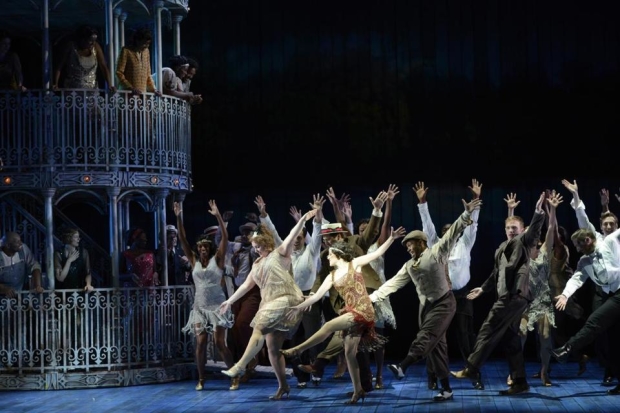Show Boat

(© Eric Antoniou)
Who would have believed that Fiddlehead Theatre Company, a formerly small-scale troupe based in a suburb of Boston, could mount such a heartfelt revival of Show Boat at the Shubert Theatre? The show is stuffed with the best talents and stage decor that money can buy. This past season, Fiddlehead has grown into the proverbial "mouse that roared" on the theatrical scene with a string of musical productions enhanced by the smarts of co-directors Meg Fofonoff and Stacey Stephens.
At the beginning of the show, we meet the elderly Kim (Kathy St. George), who is poring over her scrapbooks and sharing her memories. Kim is supposedly the link between the audience and the characters onstage. Unfortunately the talents of the highly gifted St. George are wasted in this slim role. But not to worry. While this Kim relives the past, the large ensemble filters onto the stage: a separate chorus of black actors as the deck hands and servants, and white folks as townspeople and other roles. The two-part grouping serves as a reminder that the 1927 premiere of Show Boat featured the first integrated cast on Broadway.
The story begins in 1883, on the Cotton Blossom, a show boat under the command of Cap'n Andy (John Davin, a scenery-chewing, amusing old codger), who himself is under the thumb of his nagging wife, Parthy (Dawn Tucker). The pair is raising a daughter, Magnolia, but Parthy is trying to keep her separated from the show folk, especially the mixed-blood leading lady, Miss Julie, who is married to Steve (a sympathetic Bryan Miner). Eighteen-year-old Magnolia becomes the leading lady of the show when Julie is forced to depart because marriage between a white man and colored woman is forbidden in Mississippi. Magnolia falls in love with her leading man, Gaylord Ravenal (Jeremiah James, a suitably seedy gambler), and the two marry and have a child, Kim (Addie Swan). The trio leaves for Chicago where Gaylord goes broke and ends up abandoning his wife and child. The show continues over 34 years to follow the chronicles of the characters, ending in Kim's huge success as a 1920s Broadway star (played as an adult by the adorable Megan Yates), and Ravenal's return.
The ensemble and large number of leads and actors were clearly cast for their singing chops, putting the score by Jerome Kern and Oscar Hammerstein II at the heart of the show, just where it belongs. Music director, Charles Peltz deserves kudos for melding the various voices into a splendid choral sound as well as conducting the 27-piece orchestra.
It's no small gift for a viewer to be thrilled once more by Joe (a dock worker played by the deep-voiced, authoritative Brian Kinnard) belting out "Ol' Man River," the tragic-eyed Miss Julie (a grounded Sarah Hanlon) swirling her hips in the bright and giggly version of "Can't Help Lovin Dat Man" (but not quite digging into "My Bill"). The bubbly, gorgeously full-throated ship's cook, Queenie (Lindsay Roberts), and the ingenue, Magnolia (the operatic soprano Kim Corbett), join in the first song. Not to overlook James hitting a tenor's high notes on "Only Make Believe," and the crowd-pleaser "Life Upon the Wicked Stage" gleefully pronounced by the pert Ellie (an antic Lindsay Sutton). The song-and-dance man, Carl-Michel Ogle plays her love interest, Frank Schultz, and is fast on the comebacks for their mock quarrels.
Scenic designer, Paul Tate dePoo III has created a two-story setting for the Cotton Blossom (moving on and off stage), later transforming the stage into a night club in Chicago, backed by eloquent and informative projections designed by Kevan Loney that note the change of the locales and the passage of time. Co-director Stephens has further emphasized period and spectacle in the more than 300 costumes he designed.
Best of all, however, is Fofonoff and Stephens's faith in Show Boat's old-fashioned sentimentality, which feels like a balm in our cynical times.











